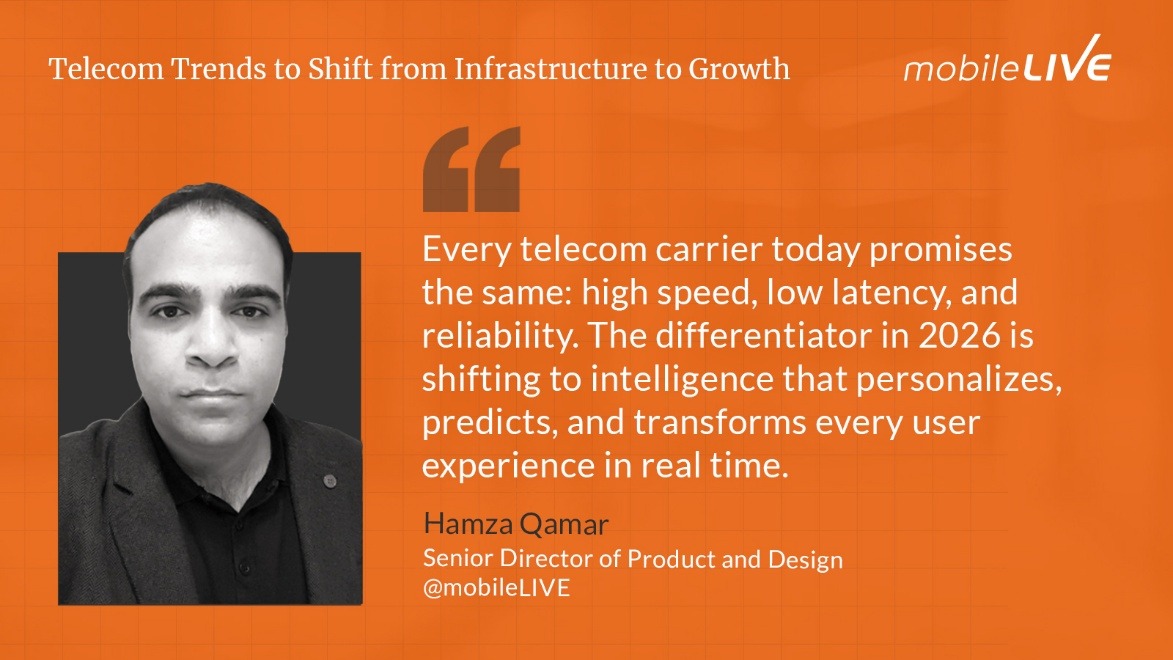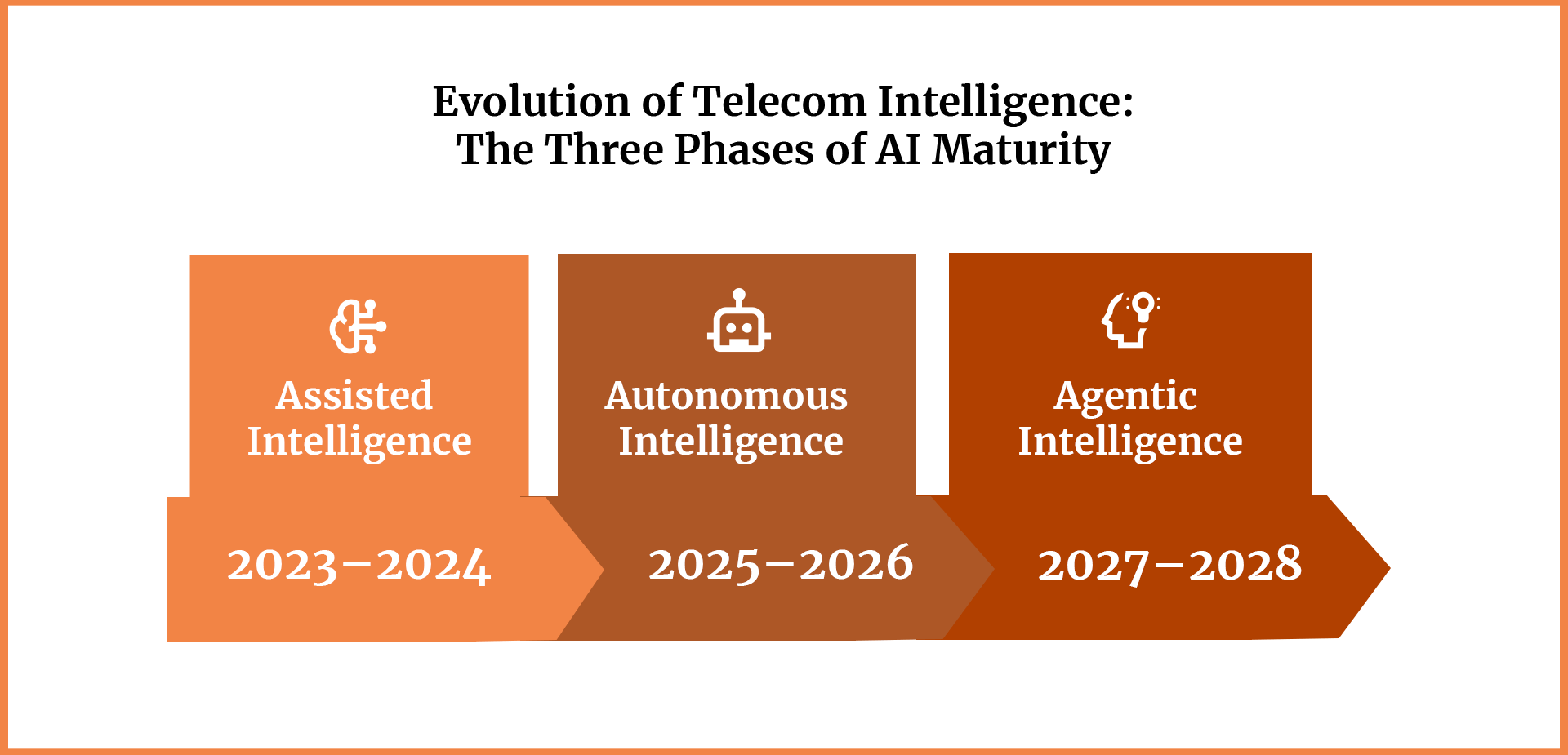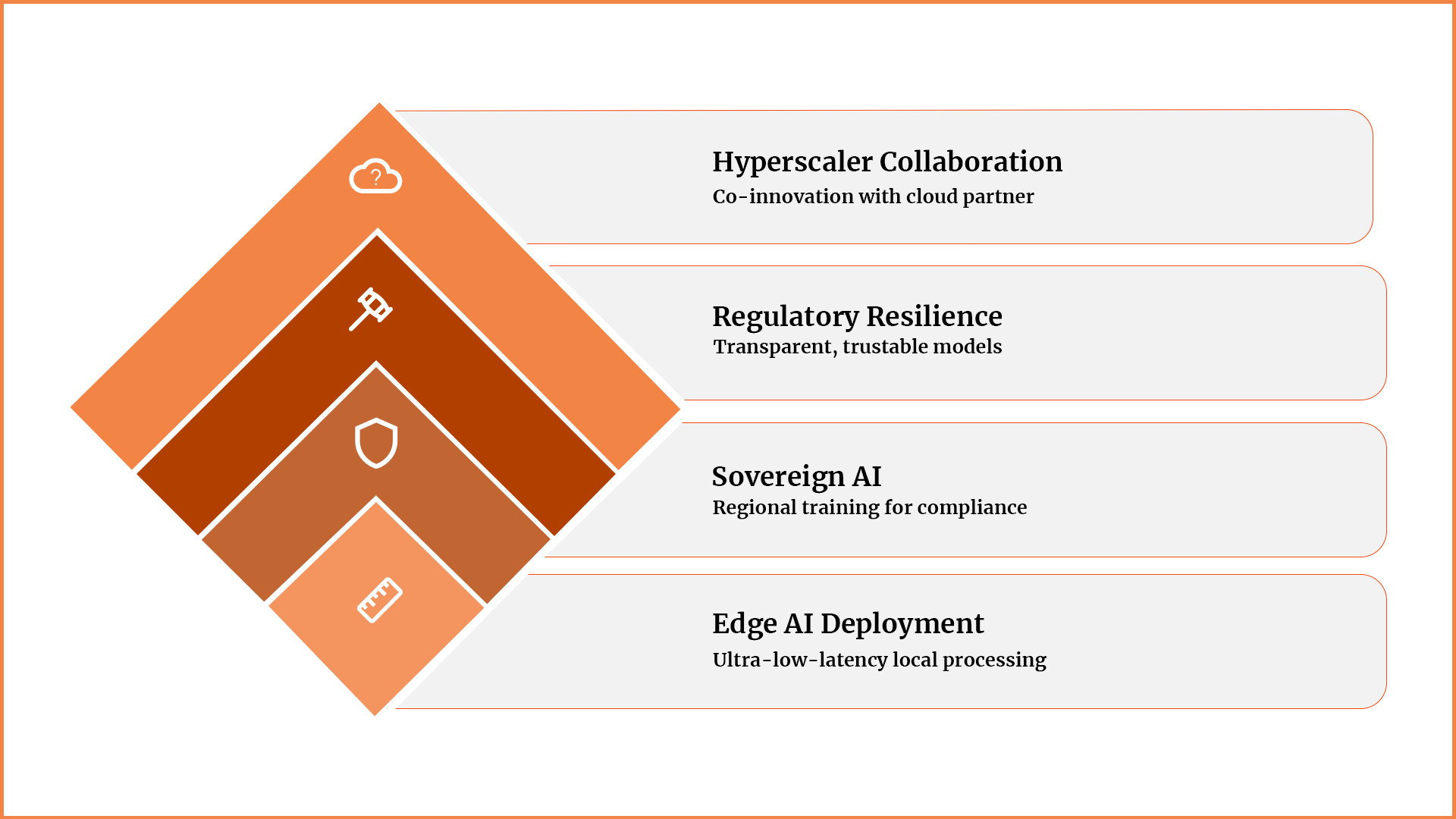
Jump To Section
- 1 Advantage is Shifting from Infrastructure to Intelligence in Telecom
- 2 The Evolution of Telecom Intelligence: How CSPs Are Progressing from Assisted to Agentic AI
- 3 How Predictive Operations Are Building Self-Healing Telecom Networks
- 4 Architectural Reinvention to Cloud-Native, Modular Intelligence
- 5 Customer Experience 3.0: The Rise of the Predictive Relationship
- 6 Governance, Ethics, and the Human-AI Partnership for Innovating Responsibly at Scale
- 7 Measuring Intelligence with KPIs that Prove Success Beyond ARPU and Churn
- 8 The Strategic Road to 2030: How CSPs Become Cognitive Orchestrators
- 9 Final Takeaway: The Living Network
- 10 FAQs
Telecommunications is undergoing its most profound transformation since the mobile internet revolution. The old era of competing on network speed and geographic coverage is ending.
In its place, a new paradigm is emerging, one defined by intelligence, adaptability, and continuous learning. As infrastructure reaches parity across markets, telecoms are no longer competing on who can connect more people or devices, but on who can understand, anticipate, and optimize those connections in real time.
According to Gartner’s Forecast Analysis for Communications Service Providers (CSPs), legacy telecom revenue will barely grow at 0.8% CAGR through 2027, signaling a structural plateau. Yet, AI-enabled service models are poised to become the new growth engine, contributing up to 20% of CSP revenue by 2030. AI and automation are not merely operational enhancements; they are the foundation of a new telecom intelligence layer.
The Market Guide for AI in CSP Network Operations (2025) notes that more than 60% of global CSPs will automate over half of their network management workflows using AI within two years. By 2026, telecoms will rely on AI systems that continuously monitor, predict, and self-correct without human supervision. These systems will define the “living network”, a dynamic, self-optimizing ecosystem where intelligence, not infrastructure, drives growth.
If intelligence is becoming the product, then strategy, operating models, and investment priorities have to move beyond asset buildouts. The next question is why this shift is happening now, and where the value pools will actually emerge for operators who commit to intelligence-first product strategy.
These are the questions we will answer in this article as we explore the 2026 telecom trends that will help you prove ROI as you transition from connectivity to intelligence.
Advantage is Shifting from Infrastructure to Intelligence in Telecom
For three decades, telecom investment centered around physical networks. Billions were spent on 5G rollouts, fiber expansions, and tower density. While this delivered global coverage, it also commoditized the core product. Every carrier now promises the same: high speed, low latency, and reliability. The differentiator is shifting to intelligence, the invisible layer that personalizes, predicts, and transforms every user experience.
Gartner emphasizes that this transition from infrastructure-first to intelligence-first is as disruptive as the leap from analog to digital. The telecoms that adapt fastest will capture outsized market share, while those that remain infrastructure-focused will see profitability erode.
New Value Streams Emerging for Telecom in 2026
Gartner and Deloitte both identify multiple high-impact sources of value creation for 2026 and beyond. These value streams extend beyond cost optimization to include strategic agility, ecosystem monetization, and long-term differentiation:
AI-Assisted Operations
Reducing operating costs by 30–40% through predictive automation and intelligent fault detection. Gartner further highlights that advanced AIOps platforms can cut incident resolution time by 60%, improving uptime and network reliability. This enables CSPs to shift resources from maintenance to innovation.
Experience Monetization
Personalizing data, entertainment, and service bundles to increase ARPU by 5–10%. Deloitte’s research adds that intelligent offer management combined with behavioral analytics can improve conversion rates by 20%, while simultaneously lowering churn.
Cross-Industry Ecosystem Expansion
Monetizing network APIs and edge computing capabilities across automotive, health, fintech, and IoT industries. Gartner predicts that by 2027, over 25% of telecom revenue growth will come from API-based collaborations and digital marketplaces.
Platform-Oriented Growth
Transitioning from service providers to ecosystem orchestrators by hosting vertical solutions such as connected vehicles, telemedicine platforms, and industrial automation. This shift aligns with Gartner’s forecast that ecosystem-driven telecom models will outperform traditional operators by up to 35% in revenue per customer.
Data Commercialization
Leveraging anonymized data for market intelligence, smart city analytics, and retail insights, unlocking new B2B opportunities while maintaining compliance through Sovereign AI frameworks.
McKinsey’s findings reinforce that CSPs integrating AI across both network and business layers can achieve up to 15% EBITDA growth within two years. They also note that these organizations typically experience higher customer satisfaction scores, faster time-to-market for new digital offerings, and stronger partner engagement.
This convergence of operational efficiency, customer intimacy, and ecosystem innovation makes AI transformation not just a technological initiative but a multi-dimensional economic imperative.
The Evolution of Telecom Intelligence: How CSPs Are Progressing from Assisted to Agentic AI

The biggest performance leap in telecom does not come from another network upgrade. It comes from graduating your intelligence layer.
When AI moves from decision support to autonomous action and finally to agentic reasoning, products stop reacting and start improving themselves with every interaction.
The maturity path for this evolution looks like this:
Phase 1: Assisted Intelligence (2023–2024)
This phase introduced AI as a support layer. Systems provided insights for human engineers — triaging tickets, correlating alarms, and predicting potential failures. These were semi-automated processes that built data literacy and operational familiarity with AI tools.
Phase 2: Autonomous Intelligence (2025–2026)
Telecoms are now entering the autonomous phase. AI agents can reroute network traffic, initiate maintenance routines, and configure systems without human approval. Gartner projects that 30% of CSPs will reach partial autonomy in their core network by 2026, reducing downtime and operational costs significantly.
Phase 3: Agentic Intelligence (2027–2028)
The final evolution introduces Agentic AI, systems that think, collaborate, and self-evolve. They will test configurations, manage capacity, and optimize resources dynamically. CSPs will move from network management to network reasoning. This phase marks the true birth of cognitive telecoms, where AI becomes a partner rather than a tool.
As intelligence matures, the operating posture flips from reactive to predictive. The immediate payoff shows up in day-to-day execution: self-healing networks, energy optimisation, adaptive capacity, and zero-touch field work move from aspiration to standard practice. For a detailed view into Agentic AI and its industry impact, read this article on How Agentic AI is Unlocking New Revenue Opportunities for Telecom.
The next section explores how operations are reimagined when prediction and prevention become the norm.
How Predictive Operations Are Building Self-Healing Telecom Networks
The next competitive leap in telecom will be won in operations, not marketing. When the network predicts failure before it happens, tunes itself for demand, and fixes issues without a ticket, reliability turns into a measurable business advantage and cost to serve drops quarter after quarter. Here we lay out how predictive operations become standard practice in 2026.
Predictive Maintenance and Self-Healing Systems
AI-driven anomaly detection models identify faults before they impact performance. Gartner’s research shows that predictive maintenance reduces downtime by 35% and repair costs by 25%. These models continuously learn, refining detection accuracy after each event.
Energy Intelligence and Sustainability
Sustainability is now a board-level priority. AI optimizes energy consumption by dynamically adjusting power usage across network nodes. Gartner projects USD 15 billion in annual savings by 2028 through AI-led power management, marking a step toward carbon-neutral telecom infrastructure.
Adaptive Capacity Management
Real-time traffic forecasting allows operators to reallocate bandwidth on demand. During major events, such as the Olympics or national emergencies, AI orchestrates capacity to maintain uninterrupted performance. This predictive agility transforms network reliability into a measurable business advantage.
Field Deployment and Zero-Touch Operations
Leading operators like SK Telecom and Telefónica are pioneering zero-touch networks, integrating AI from design to deployment. Their networks can self-diagnose, implement patches, and optimize configurations autonomously. The concept of downtime will soon be as outdated as dial-up.
Predictive operations thrive on the right technical chassis. To scale self-healing, energy optimisation, and adaptive capacity safely, CSPs need cloud native composability, edge inference close to demand, Sovereign AI for compliance, and a co innovation model with hyperscalers. The right architectural choices turn operational wins into a durable advantage, which leads into the next trend that will dominate in 2026.
Architectural Reinvention to Cloud-Native, Modular Intelligence

The biggest constraint on intelligent products is not model quality; it is the rigidity of the stack beneath them. To ship learning systems safely and at speed, communications service providers need a cloud native, composable architecture that places intelligence where it has the most impact, keeps data compliant by design, and partners for scale without surrendering domain control.
The following architectural building blocks make autonomy repeatable rather than a heroic one-off.
Cloud-Native Design and Composability
Legacy BSS/OSS systems are being replaced by modular, API-driven components. Gartner predicts that Composable BSS architectures will reduce deployment timelines by 50% by 2026. Cloud-native designs enable continuous delivery and faster product iteration, ensuring telecoms can respond to market trends in days, not months.
Edge Intelligence and Distributed Processing
By 2027, 40% of AI inference tasks will occur at the network edge. This architecture supports ultra-low-latency services such as autonomous vehicles, industrial IoT, and AR/VR. Edge AI will become the nervous system of telecom infrastructure: sensing, analyzing, and acting locally before sending data to the cloud.
Sovereign AI and Regulatory Resilience
Sovereign AI models protect regional data integrity by training within jurisdictional boundaries. For CSPs in regulated regions, this ensures compliance with privacy laws while maintaining competitive agility. Sovereign AI also enhances transparency, building trust with both regulators and consumers.
Hyperscaler Collaboration and AI Cloud Ecosystems
Telecoms are embracing partnerships with Azure, AWS, and Google Cloud. These hyperscalers provide scalable AI frameworks that CSPs can adapt to their operational needs. Gartner calls this approach the “co-innovation model”, where telcos leverage cloud ecosystems while maintaining domain control through proprietary data and algorithms.
With a composable core, intelligence at the edge, sovereign guardrails, and the right partners, the foundation is in place. The next step is where customers feel it first: turning AI into the front door of service.
In the following section, we show how this architecture powers a new customer experience where assistants resolve journeys end to end, offers adapt in real time, and quality is measured as experience, not just service.
Customer Experience 3.0: The Rise of the Predictive Relationship
The next growth engine sits where customers actually feel it. In 2026, the best telecom experiences are not just faster or cheaper; they are anticipatory. Issues are flagged before a complaint, offers fit the moment, and help resolves itself across channels without handoffs.
Here we see how AI becomes the front door for service, how personalisation moves in real time, and how experience is measured and improved continuously.
AI as the Customer Interface
By 2026, 70% of CSP customer service interactions will be managed by AI. These assistants will move beyond simple queries to become digital concierges, handling full service journeys and proactive communication.
Key Capabilities:
- Predictive Engagement: AI will monitor network quality and behavior to detect issues early, automatically open support requests, and send updates to customers.
- Emotional Intelligence: Sentiment and voice analysis will help adjust tone and escalate complex cases to human agents. Gartner expects such emotionally adaptive systems to improve satisfaction by 25–30%.
- Multimodal Support: Customers will switch between chat, voice, or video seamlessly, including AR-guided troubleshooting for devices or routers.
End-to-End Resolution:
AI will connect with billing, CRM, and marketing systems to close tickets autonomously. For example, billing errors will be identified, verified, and corrected automatically. Predictive automation could raise first-contact resolution by 45% and lower service costs by 35%.
Strategic Impact:
By linking AI agents with identity and personalization systems, telecoms will shift from reactive service to anticipatory care. This evolution builds lasting relationships and improves loyalty while reducing churn.
Hyper-Personalization and Real-Time Offers
AI continuously analyzes user data, location, and device behavior to offer personalized packages that adapt dynamically to context and user preferences. For instance, a family plan might auto-adjust during travel, high-usage periods, or when members add new connected devices. These models can incorporate contextual factors such as time of day, streaming habits, and device type to create hyper-relevant offers.
Telecoms are also deploying real-time decision engines that use reinforcement learning to experiment with micro-offers — testing different pricing, bundle sizes, or incentives across millions of interactions per day. This allows the system to continuously refine which offers perform best for each customer segment. Personalized offers can also be location-aware, pushing roaming bundles when users enter another country or promoting premium connectivity for high-traffic zones.
According to Gartner, telecoms implementing AI-driven personalization at scale have achieved up to 15–18% ARPU growth and 20% higher customer lifetime value compared to traditional static segmentation models. These dynamic systems ensure that every interaction becomes an opportunity to deliver relevance, driving loyalty and sustained engagement.
Continuous Experience Analytics
AI-driven experience analytics measure QoE (Quality of Experience) instead of just QoS (Quality of Service), expanding the evaluation beyond technical performance into human perception and engagement quality. These systems analyze how users feel and behave during interactions—tracking latency perception, emotional sentiment, and context of use—to pinpoint friction points and satisfaction drivers.
Modern analytics platforms use AI to merge network telemetry with behavioral and psychographic data, uncovering correlations between performance metrics and customer emotions. For instance, if buffering occurs during a live sports stream, the AI correlates it with churn risk and triggers automated compensation offers. These continuous feedback loops allow the network to evolve with every interaction, improving resilience and relevance. Gartner notes that AI-enabled experience analytics can raise NPS by 20–25% and reduce churn by 15–20% through real-time adaptive optimization.
Ultimately, this approach turns every user session into a data signal for improvement, ensuring that telecom networks not only maintain technical reliability but also enhance emotional satisfaction, engagement depth, and long-term retention.
As AI makes more customers face decisions in real time, trust becomes the operating system. In the following section, we cover the governance frameworks, responsible AI principles, and hybrid product teams with copilots that will keep autonomy explainable, fair, private, and resilient in 2026, so you can scale intelligence without sacrificing credibility.
Governance, Ethics, and the Human-AI Partnership for Innovating Responsibly at Scale
Trust is the operating system for intelligent telecom products. As AI shifts from assisting humans to making real time decisions, credibility with regulators and customers becomes as important as model accuracy. Responsible governance turns autonomy from a risk into an advantage by making decisions explainable, auditable, and fair across the product life cycle.
Ethical Governance Frameworks
Gartner recommends that all CSPs establish AI transparency frameworks by 2027. These frameworks mandate full explainability of algorithms, auditability of training data, and accountability for AI-driven decisions. They also define mechanisms for bias detection, continuous model validation, and data lineage tracking to ensure reliability and ethical alignment.
Leading telecoms like Vodafone and Telefónica are already piloting such frameworks, integrating automated documentation and AI audit trails into their governance models. Companies adopting these standards will not only gain regulatory and reputational advantages but also strengthen customer trust and investor confidence through transparent, accountable AI practices.
The Rise of Hybrid Product Teams
AI is augmenting human capability rather than replacing it. Product managers now rely on AI copilots to analyze market signals, simulate user journeys, and model revenue outcomes in real time. These copilots can surface emerging trends, generate user flow prototypes, and even recommend roadmap adjustments based on predictive analytics. They act as strategic collaborators, blending human creativity with machine precision.
Modern AI copilots are integrated into design, analytics, and delivery workflows, giving teams continuous access to performance data and customer sentiment insights. For instance, when planning a new feature, the AI can evaluate potential ROI, risk factors, and competitive benchmarks instantly. Teams can then test these scenarios using digital twins of customer personas before launch, significantly reducing iteration cycles.
Deloitte’s research shows AI-augmented teams achieve 25% faster innovation, 30% more accurate forecasting, and up to 20% greater decision-making efficiency than traditional setups. In telecom specifically, AI-driven product teams at large operators are using copilots to align business strategy, UX design, and technical delivery—creating a fluid collaboration model where humans focus on creative strategy while AI manages analytics and execution.
Core Principles for Responsible AI
To balance innovation with accountability, five principles are emerging as telecom standards. These principles are increasingly embedded into governance models, influencing how AI systems are designed, deployed, and maintained within telecom operations:
- Transparency: Algorithms must be explainable and interpretable, with clear documentation for decision logic and data usage.
- Accountability: Defined ownership of AI outcomes and traceability of model-driven decisions ensure responsibility throughout the product lifecycle.
- Fairness: Active bias monitoring, equitable data representation, and ethical safeguards during training prevent discriminatory outcomes across diverse user segments.
- Privacy: Localization, encryption, and anonymization of sensitive data are mandatory to align with global data protection standards such as GDPR and Canada’s CPPA.
- Resilience: Continuous retraining, validation, and stress-testing of AI models prevent drift and maintain consistency in evolving network and user environments.
Collectively, these principles form the ethical backbone for telecom AI, ensuring innovation remains transparent, compliant, and socially responsible.
Measuring Intelligence with KPIs that Prove Success Beyond ARPU and Churn
With guardrails in place and teams augmented by copilots, leaders need a shared scorecard to prove that intelligence is delivering results. We look into the evolution of the KPIs and operational benchmarks that measure learning, autonomy, and experience outcomes beyond traditional ARPU and churn, so progress is visible to executives and regulators alike.
Evolving Metrics of Success
Traditional metrics like ARPU and churn only measure surface-level performance. The intelligent telecom focuses on deeper, dynamic KPIs that reflect adaptability and foresight:
- Autonomy Index: Proportion of network operations executed independently by AI.
- Learning Velocity: Rate of AI model optimization.
- Predictive Accuracy: How often AI forecasts result in positive business outcomes.
- Experience Consistency: User satisfaction stability across touchpoints.
- AI ROI: Net financial gains from AI-led transformation initiatives.
Operational Impact Benchmarks
CSPs achieving full AI integration are already realizing:
- 40% fewer outages via predictive maintenance.
- 30% faster service restoration during disruptions.
- 20% energy cost reduction.
- 15% higher customer retention and NPS scores.
These metrics redefine success in an era where intelligence, not infrastructure, drives value.
With a shared scorecard, direction becomes the advantage. The final step is setting a destination.
Next, we look to 2030: how communications service providers evolve from connectivity to cognitive orchestration, and the strategic imperatives that turn today’s capability gains into tomorrow’s platform leadership.
The Strategic Road to 2030: How CSPs Become Cognitive Orchestrators
By 2030, CSPs will transcend connectivity, becoming orchestrators of connected ecosystems that span industries and user experiences.
Gartner predicts that over 70% of telecom revenue will come from AI-powered digital platforms capable of integrating communication, data, and intelligence across sectors. Telecom networks will underpin the infrastructure for smart cities, connected healthcare systems, digital finance platforms, and autonomous logistics networks.
In these ecosystems, telecom operators will not only provide bandwidth but also manage identity, security, and real-time decision frameworks. Edge computing, combined with AI, will allow networks to coordinate traffic flows, healthcare diagnostics, and financial transactions seamlessly.
Moreover, CSPs will act as brokers of digital trust, enabling cross-industry data exchanges and monetization models. Gartner’s outlook suggests that telecom operators embracing this ecosystem-centric approach could increase enterprise customer share by 40% and achieve higher resilience against economic cycles through diversified revenue streams.
Strategic Imperatives for Transformation

To thrive in this new era, CSPs must pursue a comprehensive transformation strategy that integrates technology, talent, and governance. This roadmap goes beyond modernization — it emphasizes operational intelligence, responsible innovation, and cultural readiness for a data-first future:
- Rebuild architectures for agility through cloud-native, modular systems. CSPs should replatform legacy OSS/BSS into composable frameworks, allowing faster rollout of services and simplified integration with ecosystem partners. Modular architecture enables experimentation, rapid scaling, and continuous innovation.
- Deploy AI operationally across every network and customer domain. This means integrating AI into predictive maintenance, fraud detection, service assurance, and customer experience layers. By embedding AI at each stage of the service lifecycle, CSPs can achieve self-optimizing networks and personalized service delivery at scale.
- Institutionalize AI governance and ethical standards. Establish centralized AI governance boards that oversee data ethics, transparency, and accountability. Develop standardized frameworks for model validation, bias detection, and explainability, ensuring that AI decisions align with regulatory and brand values.
- Adopt sovereign AI frameworks for trust and compliance. Deploy region-specific AI infrastructures that respect local data sovereignty laws and security mandates. This approach protects customer data while enabling cross-border innovation and interoperability.
- Cultivate human-AI hybrid leadership that unites analytics, empathy, and foresight. Future telecom leaders will manage symbiotic teams where AI copilots assist in decision-making, risk analysis, and trend forecasting. Training programs must focus on digital fluency, ethical reasoning, and adaptive management to prepare leaders for this collaboration-driven environment.
- Invest in ecosystem orchestration by forming strategic partnerships with hyperscalers, startups, and industry alliances. This expands innovation pipelines and creates shared value ecosystems that accelerate AI adoption.
- Embed sustainability metrics within AI and automation strategies. Integrating carbon footprint monitoring, energy optimization, and responsible resource management into product design ensures long-term resilience and ESG compliance.
The operators that win the next decade will not be known for the size of their networks but for the platforms they orchestrate. By 2030, telecoms that master intelligence at scale will sit at the centre of cross-industry ecosystems, coordinating identity, security, data, and real-time decisioning across smart cities, connected health, digital finance, and autonomous logistics and turning capability gains into durable platform leadership.
Final Takeaway: The Living Network
Telecom is evolving from a static utility to a sentient, learning organism.
By 2026, leading operators will no longer merely connect devices: they will predict user needs, anticipate network challenges, and deliver services that evolve in real time. Intelligence is becoming the new infrastructure.
And by the end of the decade, networks will function as cognitive ecosystems that collaborate with users, enterprises, and other digital systems to deliver personalized and adaptive experiences. These intelligent networks will continuously learn from every data exchange, optimizing energy consumption, service quality, and customer engagement.
As telecom becomes central to digital life, its role will expand beyond connectivity into enabling the world’s cognitive economy, a foundation where human decisions and machine intelligence operate in harmony to drive innovation, sustainability, and growth.
FAQs
1) What should telecom executives do first in 2026 to realise ROI from AI in telecom?
Start with a 90-day pilot in predictive operations (self-healing or predictive FCR in care) using bounded autonomy and rollback. Track avoided incidents, time-to-restore, energy savings, and cost-to-serve to prove value, then expand the action space.
2) How can a mid-market CSP modernise architecture for AI without a full replatform?
Carve a thin, composable BSS/OSS slice (API-first catalog, charging, policy), add edge intelligence for low-latency inference, and create a Sovereign AI lane for residency and auditability. This enables one end-to-end intelligent journey to ship now while the broader replatform proceeds.
3) Which telecom AI KPIs prove success beyond ARPU and churn in 2026?
Use a capability scorecard: Autonomy Index, Predictive Accuracy, Learning Velocity, Experience Consistency, and AI ROI. Pair with outcome benchmarks (fewer outages, faster restoration, energy savings, higher NPS/retention) to tie intelligence directly to financial impact.
4) How do we stay compliant and trustworthy while scaling agentic AI in telecom?
Adopt Sovereign AI (train/serve in-region), maintain decision logs and model lineage, and enforce bias/robustness tests per release. Use risk tiers, human-in-the-loop thresholds, and explainability artifacts to satisfy CPPA/GDPR and enterprise procurement.
5) What is the go-to-market to monetise intelligent services and network APIs in 2026?
Productise network and intent APIs with clear SLAs and usage-based pricing; bundle AI-powered insights (QoE guarantees, priority lanes) into premium tiers. Co-sell with hyperscalers/ISVs, measure win rate and expansion ARR, and sunset low-margin offers as intelligent tiers scale.



